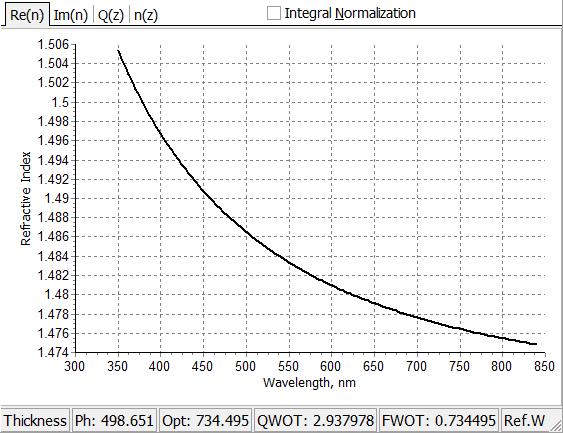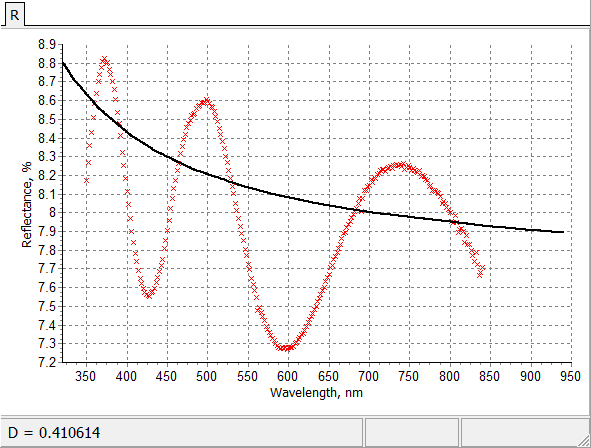| OptiChar enables the optical characterization of single layer films via spectro-photometric and/or ellipsometric data.
In OptiChar, a thin film is represented by a model including spectral dependencies of refractive index and extinction coefficient, film thickness, dependence of optical parameters on the thickness of a thin film (bulk inhomogeneity), thickness of surface overlayer, and porosity. OptiChar allows you to determine: |
 |
| The thin-film model can be described by a vector of model parameters \(X\). The coordinates of the vector \(X\) can be the parameters describing wavelength dependencies of the refractive indices/extinction coefficients, film thickness, degree of bulk inhomogeneity, porosity, thickness of the surface overlayer etc. The model parameters are determined by the minimization of the discrepancy function \(DF\) estimating the closeness between experimental and model data:
\[ DF^2(X)=\sum\limits_{j=1}^N \left[\frac{S(X;\lambda_j)-\hat{S}(\lambda_j)}{\Delta_j}\right]^2, \] where \(S\) is the spectral characteristic of the model film, \(\hat{S}\) is the corresponding experimental spectral characteristic, \(\{\lambda_j\}\) is the wavelength grid in the experimental spectral range, \(\Delta_j\) are measurement tolerances. If spectral characteristics (transmittance, reflectance) are measured in %, and then the default \(\Delta_j\) values for OptiLayer, OptiChar, OptiRE is 1%. In this case, the value of \(DF\) around one means that RMS deviation of model data from the experiment one is about 1%. This value should be compared with expected accuracy of your measurements. This expected accuracy should include not only random noise, but also systematic errors (drifts, offsets). |
|
 |
A special interface provides an opportunity for a flexible and well-grounded choice of the specific thin film model depending on the available experimental data, its accuracy, and a priori information about the optical properties of the thin film under consideration.
Sophisticated mathematical algorithms enable you to reliably study even the most fine effects in thin films caused by a small absorption, small bulk and surface inhomogeneities. Using OptiChar you can process:
|
There are multiple factor affecting accuracy of the characterization results even in simplest characterization problems. Among them are:
|
Important: you should avoid so-called over-fitting problem. It means that you should not try to minimize the discrepancy function \(DF\) below the accuracy of measurements. For example, if you estimate your accuracy of measurements as 0.5% (including also systematic deviations), you should not try to obtain \(DF\) below 0.5 (if measurement tolerances in the Measurement Editor Tolerance column is 1%).
If you specify Tolerances as real expected accuracy at each wavelength (Woollam Ellipsometers provide this information, for example), then you should not try to minimize \(DF\) below 1. When you reach this threshold value, you should stop and try to analyze the results. |
All our characterization models and methodology have been verified in the frame of collaboration with scientists from world leading research groups.References:
|
|
Look our video examples at YouTube
OptiLayer videos are available here:
Overview of Design/Analysis options of OptiLayer and overview of Characterization/Reverse Engineering options.
The videos were presented at the joint Agilent/OptiLayer webinar.